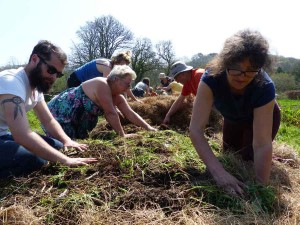Comfrey tea
Many people will advise you that comfrey tea is made by steeping comfrey leaves in a barrel of water and leaving to fester and stink. This is wrong! I’ve even heard Bob Flowerdew going on about what a horrible smell. I (Nicky) was a student at Henry Doubleday Research Association (now Garden Organic https://www.gardenorganic.org.uk/ ) and I have been doing this for decades now, smell free! Simply cut your comfrey and of course by comfrey I mean Russian Comfrey which is a vigorous hybrid and Lawrence Hills, who founded HDRA selected several clones, ‘Bocking 14’ is the one used by gardeners. You can buy it from Garden Organic as root sections, it doesn’t set seed but will grow very vigorously from root or even leaf cuttings, so be careful if you are cutting it in wet weather as you can tread even bits of leaf into the soil and if it continues damp it will root! I cut the whole plant down with a scythe and barrow it to my barrel which has a hole in the bottom, I set the barrel on blocks with a piece of pond liner underneath to divert the liquid which runs out in about 10 days usually. A weight on top helps and you can chop the leaves with a spade and push into the barrel as hard as you can. The concentrate can be bottled and you need to dilute, I just think of weak fruit juice concentrate type of dilution. have a look at the slide sequence below. Comfrey tea is full of potash, nitrogen and minerals is great for all your plants especially fruits like tomatoes, squashes and all soft and top fruit.
Lasagna gardening
Lasagna gardening, also called barrier mulching is a great technique for clearing ground without digging. you can create a garden really quickly either for sowing or planting up and you can use any compostable materials. It does mean you need to gather together lots of stuff including the ‘barrier’ materials. Large cardboard boxes are the best for this, remove all the plastic  tape first, now level the area as best you can. Scythe or mow any top growth off and rake to one side to use as a lasagna layer later, or just leave where it is. Cover the area with overlapping cardboard and cover the overlaps with newspaper. Wet it as you go to stop it blowing around. Then cover this with your next layer, compost, even unfinished compost, manure, again at any stage (this does depend a bit on time of year and whether you want to plant up or sow straight away). You could cover a layer of half composted manure with a layer of old straw or hay for instance, this will help the manure to keep moist and continue breaking down. Each layer will have an effect on the layer below. If you want to sow you will have to finish off with a generous layer of finished compost, but if you are growing potatoes for example as in the pictures here it’s very easy to just burrow them in under a layer of loose hay of straw and then you can ‘earth’ them up with grass cuttings, or more organic materials as the shoots come through. Have a look through the gallery below to see how it can be used to create a new bed, it helps to have many hands like here on a training day at Embercombe, or around raspberries or other established plants, and even as in the slides showing logs a sort of above ground mound garden. This is from Holland and its Debra Solomon’s work with Urbania Hoeve Have a look at this fascinating work!
tape first, now level the area as best you can. Scythe or mow any top growth off and rake to one side to use as a lasagna layer later, or just leave where it is. Cover the area with overlapping cardboard and cover the overlaps with newspaper. Wet it as you go to stop it blowing around. Then cover this with your next layer, compost, even unfinished compost, manure, again at any stage (this does depend a bit on time of year and whether you want to plant up or sow straight away). You could cover a layer of half composted manure with a layer of old straw or hay for instance, this will help the manure to keep moist and continue breaking down. Each layer will have an effect on the layer below. If you want to sow you will have to finish off with a generous layer of finished compost, but if you are growing potatoes for example as in the pictures here it’s very easy to just burrow them in under a layer of loose hay of straw and then you can ‘earth’ them up with grass cuttings, or more organic materials as the shoots come through. Have a look through the gallery below to see how it can be used to create a new bed, it helps to have many hands like here on a training day at Embercombe, or around raspberries or other established plants, and even as in the slides showing logs a sort of above ground mound garden. This is from Holland and its Debra Solomon’s work with Urbania Hoeve Have a look at this fascinating work!
Lasagna gallery below


























